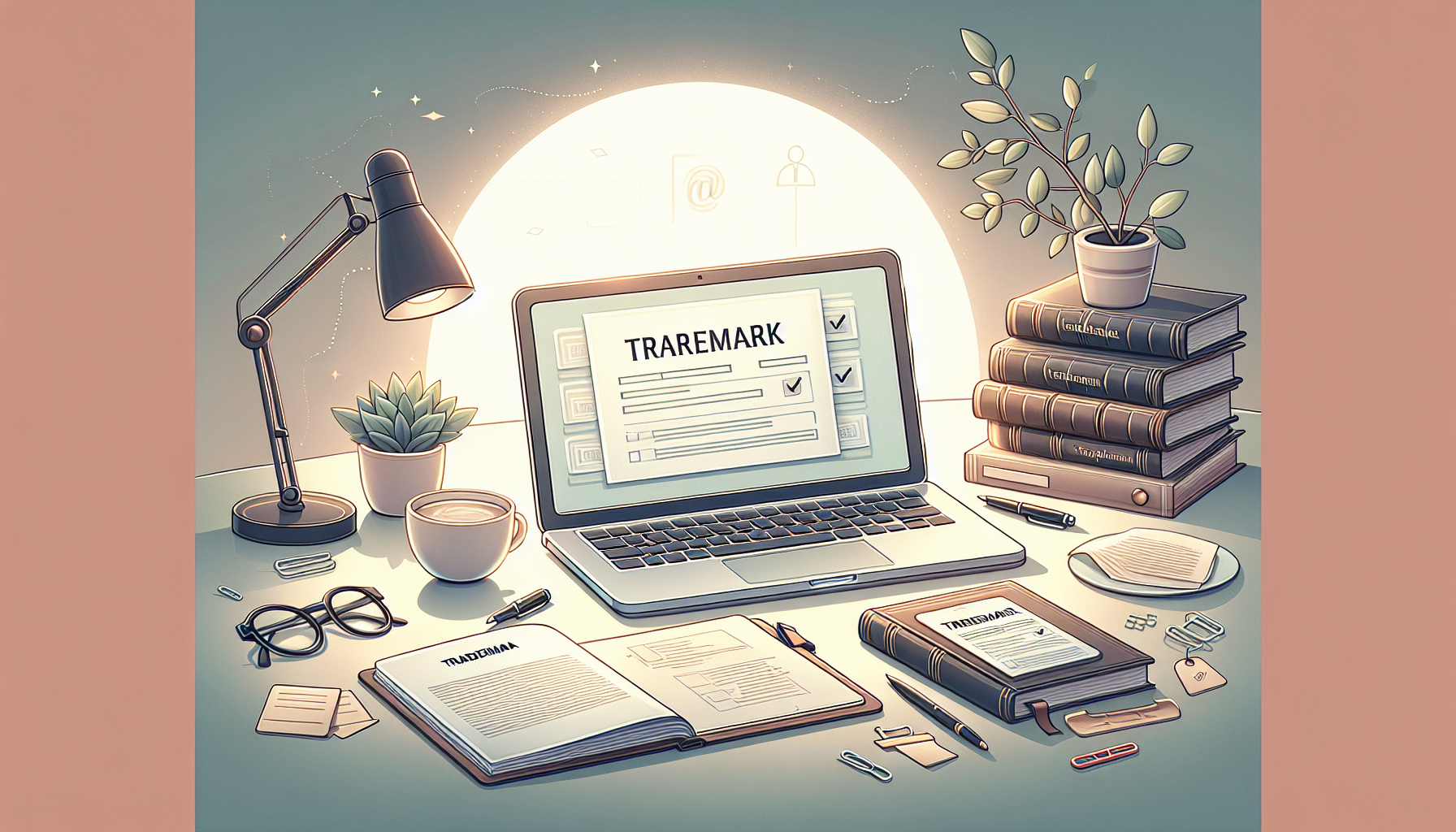Registering a trademark can feel overwhelming, right? With all the rules and paperwork, it’s easy to wonder if it’s even worth the hassle. You’re not alone in feeling that way—it’s a common hurdle for many aspiring business owners and creative minds trying to protect their valuable ideas.
But don’t worry! If you stick around, you’ll find useful prompts and steps to simplify the trademark registration process. By the end of this, you’ll have the tools to confidently navigate your journey toward trademarking your unique brand.
We’ll cover everything from understanding the process to generating catchy name ideas and what to do after you’ve secured your trademark. Let’s dive in!
Key Takeaways
- Trademark registration helps protect your brand and is essential for business owners.
- Use effective prompts with tools like ChatGPT to generate unique brand names and taglines.
- Follow a structured process: check eligibility, conduct a trademark search, and draft your application.
- Consider factors like distinctiveness and appropriate trademark classes before applying.
- Prepare for a review period that can take six months to a year and be ready for potential requests from the USPTO.
- After registration, monitor your trademark’s use, renew it on time, and update it as needed to maintain protection.

Effective ChatGPT Prompts for Trademark Registration
Leveraging ChatGPT for trademark registration can streamline your brainstorming process and help generate creative ideas.
Here are some effective prompts you can use:
- Create a list of unique brand names suitable for a tech startup.
- Suggest creative taglines for a new fashion brand.
- Generate synonyms for the word “green” in the context of eco-friendly products.
- Provide a summary of trademark eligibility criteria for small businesses.
- List potential trademark classes for a food delivery service.
- Analyze the risks of using a name already trademarked.
- Outline the steps involved in filing a trademark application.
Understanding the Trademark Registration Process
The trademark registration process can seem daunting, but breaking it into steps makes it manageable.
First, ensure your trademark is eligible by checking if it’s distinctive and not already in use.
The next step involves conducting a comprehensive trademark search to avoid conflicts.
Once your search is clear, you can proceed to fill out the application, which typically includes providing a description and examples of how the trademark will be used.
After submission, it’s time to wait for the USPTO to review your application, which can take several months.
During this period, be prepared for any office actions or requests for more information.
Key Considerations Before Registering a Trademark
Before registering a trademark, it’s important to consider several key factors to ensure your application is successful.
Firstly, assess the distinctiveness of your trademark. A unique name has a higher chance of approval.
Conduct a thorough trademark search to identify any potential conflicts.
Consider the specific trademark classes that apply to your product or service; registering under the right category is crucial.
Also, think about the legal implications; trademark registration can prevent others from using your brand without permission.
Lastly, consider the long-term strategy for your trademark. Will you want to expand its use or update it in the future?
Common Questions about Trademark Registration
Many people have questions about trademark registration, and understanding the answers can clarify the process.
One common question is, “How long does trademark registration take?” The process can take anywhere from six months to a year, depending on various factors.
Another frequent query is about the costs associated with registration, which can vary based on the number of classes and whether you hire a legal professional.
Many wonder, “What can actually be trademarked?” Generally, words, logos, and slogans that identify the source of goods or services can be registered.
It’s also important to debunk some myths surrounding trademark registration like thinking it’s only for large corporations; small businesses should consider it too!
If you’re interested in exploring more creative prompts, like those that can help with writing essays or mental health topics, check out these resources: prompts for college essays and prompts for mental health.

“`html
Using ChatGPT to Generate Trademark Name Ideas
Using ChatGPT to brainstorm trademark name ideas can save you time and spark creativity.
Start by asking for names that convey the essence of your brand.
Here are some prompts you can copy and paste into ChatGPT to generate trademark name ideas:
- Generate five unique and catchy names for a sustainable clothing brand.
- Suggest ten memorable names for a gourmet food delivery service.
- Create names for a technology-focused educational platform catering to children.
- List creative names for a mobile app that connects freelancers with clients.
- Provide a set of catchy brand names for an artisanal coffee shop.
- Brainstorm clever names for a subscription box service featuring local products.
- Come up with playful and engaging names for a pet grooming business.
These prompts can help you explore different angles and ensure that you find a name that resonates with your target audience.
Once you have a list of potential names, consider running them by a trusted group for feedback.
Steps to Take After Trademark Registration
Once your trademark is registered, there are several important steps to ensure your rights are protected.
First, keep a record of your trademark registration details. This makes it easier to renew and monitor your trademark later.
Next, monitor the market for any unauthorized use of your trademark.
To help with this, you can set up Google Alerts for your trademark name.
If you find someone infringing on your trademark, act quickly. You may need to contact a lawyer for guidance on your options.
Another important step is to use your trademark consistently in branding and marketing. This helps to maintain its legal protection.
Don’t forget about renewal. Check the renewal dates on your trademark and be sure to file the necessary forms on time.
Finally, consider updating your trademark if your business expands or changes direction. This keeps your brand fresh and relevant.
Incorporating these steps will help you effectively manage your trademark now that it’s registered.
“`

Resources for Trademark Registration Assistance
Finding the right resources for trademark registration is key to navigating the process smoothly.
Start with the USPTO website, which is a treasure trove of information about the trademark application process.
You can access their online database, called TESS, to check existing trademarks before you file yours.
If you’re looking for professional help, consider hiring a trademark attorney who can guide you through the legal nuances.
For budget-friendly options, several online platforms offer trademark registration services at a fraction of the cost.
Websites like LegalZoom and Trademarkia provide comprehensive packages that can handle everything from searches to filings.
Additionally, you might find local workshops or seminars hosted by legal firms that can give you personalized guidance.
Don’t forget to check out resources like the International Trademark Association (INTA), which provides educational materials and tools for trademark registrants.
Here are some ChatGPT prompts to help you research resources:
- List top online resources for trademark registration assistance.
- Provide a summary of the services offered by trademark registration platforms.
- Suggest questions to ask when hiring a trademark attorney.
- Identify common mistakes made during the trademark registration process and how to avoid them.
Using these resources will ensure that you have the right support as you move forward with your trademark registration journey.
FAQs
The trademark registration process involves submitting an application to the relevant authority, conducting a search for conflicts, reviewing the application, and, if approved, publishing the mark for opposition before final registration.
Before registering a trademark, consider its distinctiveness, potential for conflicts with existing marks, the availability of similar names, and your intended use in commerce to ensure lasting protection.
Yes, ChatGPT can help generate unique and creative trademark name ideas. Provide some keywords or themes, and it can suggest various options tailored to your preferences and industry.
After registering your trademark, monitor its use, renew it as required, enforce your rights against infringements, and use the trademark consistently to maintain its protection and value.
